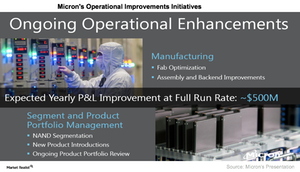Micron’s Strategy to Improve Operational Efficiencies
Micron Technology (MU) entered the 3D NAND market earlier than its competitors, as its planar NAND did not deliver good returns.
March 24 2017, Updated 7:36 a.m. ET

Micron’s strategy to improve operational efficiencies
In the previous part of this series, we saw that Micron Technology (MU) expects to report strong profits that are significantly higher than the analysts’ estimates. The profitability would largely be driven by product mix, higher prices, and operational efficiencies.
At the Morgan Stanley Technology, Media, and Telecom Conference, Micron Technology’s chief financial officer, Ernie Maddock, stated that the company plans to reduce its cost by $500 million annually by improving its operational efficiency.
Fab optimization
Micron’s Technology (MU) first initiative toward reducing costs is by optimizing its fabrication facilities, or fabs. It decided to produce every product at only two fabs instead of four or five. This would help it squeeze out an extra 1%–2% wafers per month from the fabs, remove redundancies, and significantly improve its cost structure.
Micron Technology has already achieved significant improvement in DRAM manufacturing with the acquisition of Taiwan-based (EWT) Inotera. It is implementing the same initiative for 3D NAND. It already manufactures 3D NAND in Singapore (EWS) and is converting its DRAM fab in Manassas, Virginia, to NAND.
At the end of 2016, 10% of the Manassas fab started building 3D NAND. There is a possibility that the company is jumping directly to producing 3D NAND Generation 2 at the Manassas fab, which is expected to reduce its cost 30% and improve its yield 80%.
Micron Technology is also looking to bring the assembly and backend operations closer in order to remove the redundancies between the network. This manufacturing optimization would help it reduce the cost of goods sold.
NAND segmentation
Micron Technology (MU) entered the 3D NAND market earlier than its competitors, as its planar NAND did not deliver good returns. This helped Micron reenter the end markets such as storage and SSD (solid-state drive) where NAND is in great demand.
The company plans to revise its NAND portfolio for high-margin markets. For instance, Micron started selling 5100 SSD and 3D TLC (triple-level cell) SSDs, which gave it a higher margin than the NAND sold in the spot market. Even Western Digital (WDC) acquired SanDisk to gain exposure in the high-end SSD market.
Dynamic product portfolio
Micron Technology is developing new products and reviewing its existing products on a regular basis to make its product mix profitable. It decides the product mix in a way that maintains a balance of short-term profit opportunity and long-term strategic customer opportunities while considering the recent trends in the spot or the transitional markets.
Next, we’ll look at Micron Technology’s strategy to improve its working capital.
